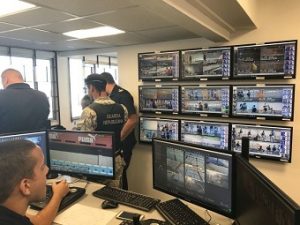
Violence in sports events is an important social problem in several Latin American countries. Uruguay is no exception, and in recent years there have been numerous serious episodes in the field. Due to this escalation of violence, it is in 2016 that Uruguay’s security authority, the Ministry of Interior, asked the Uruguayan Football Association to implement a security system to address this problem.
“This is a very important step and a great contribution to football because this system will also be a very important tool for the authorities,” said Wilmar Valdez AUF, President.
The system is used by many people of different profiles, technical and non-technical. The challenge was to achieve a user-friendly, intuitive system with appropriate training so that both the operational staff and the police could make the most of the tools.
The three stages where this system was implemented are different. The design of the project had to contemplate the Centennial Stadium, built-in 1930 with very little maintenance, the Champion of the Century Stadium, built-in 2016, and the Grand Central Park Stadium, undergoing remodelling and constant works during implementation. This was a very rewarding challenge in the management of the project to be able to meet the objectives of the project and the times committed.
The entire system designed should be robust, scalable and in a high availability scheme, the access control system would become a key element in the stadiums’ qualification. This is why extreme collections of redundancy and high availability are taken.
To meet this challenge, DDBA turned to the integration of technologies from several pioneering companies in the market, such as Axis for cameras, Herta for facial identification, Wavestore as VMS, and Huawei for networking. The main approaches were: –
• Turnkey and robust system
• Design of transportable and autonomous mobile units
• Centralised connectivity
• Ticket control to reduce access time, according to FIFA regulations
• Video Management System without blind spots in the stands FIFA.
Herta uses BioSurveillance NEXT in all the cameras of the stadium access doors. This product allows facial identification in crowds with a speed of millions of comparisons per second, which makes it appropriate for the flows of people entering the stadiums.
In the cases where the software detects an unauthorised person to access, in addition to the warning on the screens of the monitoring centre, it sends alerts to tablets that are used by the police located at each access door so that they can act immediately and prevent unauthorised access. A central database (BioMaster) located in the Ministry of Interior synchronises the blacklist with all stadiums and mobile stations.
Any addition or modification in this database updates all points in real-time. This central base also centralises the identification alerts of all the servers of the stadiums and mobile stations. “The facial identification is done at the entrance of people and then there is an internal camera system that films and can recognise all the spectators who are in the stadium. It is a biometric work and its effectiveness is 99%,” said Germán Ruiz DDBA Technical Manager.
Positions for forensic work were implemented to be able to perform subsequent analysis using Herta’s BioFinder and BioCompare. These two tools allow you to search for subjects on recordings (BioFinder) and also on the images taken by BioSurveillance of all cameras (BioCompare). These workstations were placed in the forensic analysis room of the Ministry of Interior, from where all storage servers are accessed.
There have been highly positive results on four levels:
• Numerous people have been arrested at the entrance that was already blacklisted.
• It has been enlisted as subjects to identify in the blacklist people with improper behaviour (violence, flares in stands, etc.) inside the stadium thanks to the quality of the images. Subsequently, several of these people have been arrested while trying to access in later matches. At that time they were identified and the registration was made to the list of Non-Admitted with their complete data, making use of the law of admission.
• The behaviour within the stadiums has improved substantially and the system has resulted in a disincentive of incidents.
• The number of police officers assigned to the parties is decreasing. In fact, there have been no incidents of magnitude during 2017 and the number of arrests has fallen by 80% according to figures from the Ministry of Interior (Commissioner Pablo Duarte, Head of the Technology Department of the Ministry of Interior).











